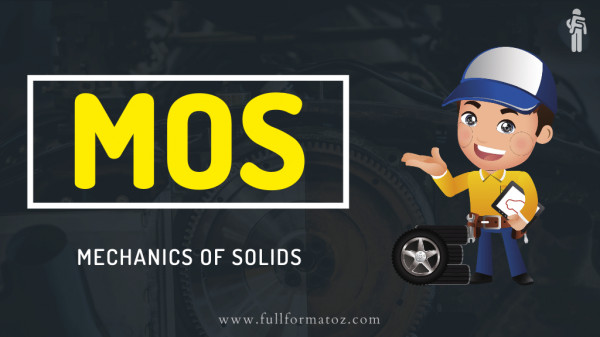What is the Full Form of MOS in Mechanical Engineering?
 |
Full Form of MOS in Mechanical Engineering - Full Form, Meaning, and Definition
The full form of MOS in Mechanical Engineering is: MECHANICS OF SOLIDS
What is the meaning of MOS in mechanical engineering?
Mechanics of solids (also known as solid mechanics) is one of the fundamental applied engineering sciences and is the study of the behavior of solid materials.
MOS studies the motion and deformation of solids when they come under the action of forces and is a very vast subject.
These forces may include temperature changes, tension forces, spring forces, etc.
What are the Best ways to learn the mechanics of solids? (Best books to refer to for MOS)
You can learn the mechanics of solids by reading journals, articles, books, etc., and by making sure that all your concepts are clear.
Following are the books you can refer to for a clear understanding and gain more insights on the subjects:
- A Textbook of Strength of Materials (R K Bansal)
- Strength of Materials (S. Ramamrutham)
- Mechanics of Materials by Gere and Goodno of Cengage Publications
- Introduction to Mechanics of Solids by Crandall
- Strength of materials by Gere and TiMOShenko
Is the mechanics of solids and the strength of the material the same?
MOS and Strength of Materials are not the same with Strength of Materials being a part/constituent of Mechanics of Solids.
Strength of Material helps the engineer in identifying the strength of a material by measuring its stress and strains upon subjecting forces on the solid.
Also Read: What is the Full Form of ICSE Board?
What is computational solid mechanics?
Computational solid mechanics is a branch of mechanics that deals with the numerical analysis of the behavior of solid materials under various loading conditions.
It involves the use of computer algorithms and numerical methods to simulate and predict the behavior of solids, including their deformation, stress, and failure.
Computational solid mechanics is used in various fields, including aerospace, civil, mechanical, and materials engineering, to design and analyze structures and components.
The use of computational techniques enables engineers to optimize the design of structures and materials, reduce development costs, and improve the safety and reliability of products.
What is load in solid mechanics?
The forces which are given externally on the materials are called ‘load’. The following are the reasons for the applied forces.
Because of the environment where the components work.
- Due to service conditions.
- Due to the pressure of the liquid.
- Because of gravity or inertia.
- Due to the contact with other materials.
What are the aspects of MOS?
 |
- It examines if any structure can go back to a given equilibrium after partially being failed.
- Materials that emerged from thermodynamic principles are analyzed by it.
- It makes use of solid mechanics to biological materials.
- MOS also deals with those mechanical systems which are highly delicate in their early stages.
- It applies solid mechanics to geological things like ice, rock.
- The examination of vibration and waves from vibrating particles is very vital in mechanical engineering.
- It deals with fractures in solid materials.
- MOS also manages variational formulation of Mathematics arising from different branches of solid material.
Applications of MOS Technology:
MOS technology is used in various electronic devices and systems, including:
- Microprocessors: Microprocessors are the central processing unit of a computer. MOS technology is used to create millions of MOS transistors on a single chip, making it possible to create powerful processors with a small form factor.
- Memory Chips: MOS technology is used in the creation of memory chips, including RAM and ROM. MOS memory chips have high storage density and low power consumption, making them ideal for portable devices like smartphones and tablets.
- Analog Circuits: MOS technology is also used in the creation of analog circuits, including amplifiers, filters, and oscillators. MOS analog circuits have high gain, low distortion, and low power consumption, making them suitable for various applications.
How does a solid respond to applied stress?
- Elasticity: When employed stress is released the material goes back to its normal state.
- Plasticity: When the applied stress is higher than the required stress then the material behaves plastically and it never goes back to its undeformed stage. In this case, the deformation is permanent.
- Viscoelasticity: These are some materials whose response depends on time. These things act like elastic but also have humidity. Hence when stress is given and removed the material becomes like a hysteresis loop.
- Viscoplasticity: It is a combined theory of viscoelasticity and plasticity. It is applied to materials like gel, clay, etc.
- Thermoelasticity: It is about elastic solids that are neither adiabatic nor isothermal.
Join the conversation